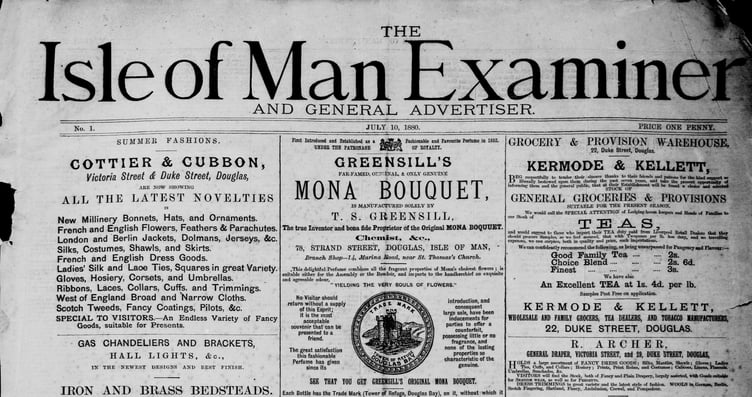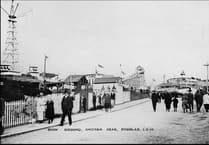There is a long history of Isle of Man newspaper publishing, this particular title, being the oldest.
The Isle of Man Examiner, was established in 1880. The Ramsey Courier was founded in 1884 and, in 1981, became the Isle of Man Courier, a free, delivered newspaper.
The Manx Independent was launched in 1987 by journalists including Bill Dale and others who had been involved in industrial disputes with the then owner.
Other historic titles which subsequently merged or closed included Mona’s Herald, Manx Sun, Isle of Man Times, Isle of Man Weekly Times, Manx Star, and a particular favourite of mine - the Green Final.
Early on a Saturday evening, lots of people would queue outside newsagents to grab their copy, hot off the press, to get all the local football and other sporting results.
These days, modern technology has enabled an online news presence alongside others for Media Isle of Man with iomtoday.co.im.
What other things have changed? Who remembers the detailed birth and marriage announcements - sometimes with a full page of photos of newly married couples? Or wills and house sales? Another feature was the daily or weekly lists of ships arriving and departing Douglas, Ramsey, Castletown and Peel harbours, including names of captains, cargos, passengers, and weather conditions.
An example from a 1920s Examiner: ‘The Lady of Mann arrived at 11.20am from Liverpool carrying 200 passengers.’
That must have been during the winter, as during the summer months the IoM Steam Packet fleet was working hard and full to capacity.
Whilst today’s newspapers cover some court reporting in cases of public interest - taking on board ethical codes and privacy concerns - newspapers used to feature verbatim reports of minor court cases, complete with names, addresses, occupations, and fines, sometimes even with commentary about ‘moral standards’ etc.
During my early years as a Tynwald member and before, I clearly recall the often verbatim reports of proceedings by legendary reporter Harry Bregazzi and others (compulsive reading?).
Each village or parish had a social correspondent sending in ‘Ramsey Notes’, ‘Ballaugh Items’, or ‘Port Erin News’, covering all sorts of things from coffee mornings and so on.
One newspaper issue could cover a dozen or so such columns. Of course, perhaps the best-known social correspondent on all matters was ‘Fenella’.
Who remembers the Peel City Guardian, first published in 1882, bringing news and information to the west of the island until 2001? There was then a three-year gap until owners Ian and Clare Faulds gave the rights to the title to Peel Heritage Trust.
There used to be newspaper columns on church socials, Sunday school anniversaries, parish concerts and Women’s Institutes. Whilst some coverage still remains, lifestyle pages now lean more towards arts and entertainment.
So how about the 1960s onward? With the popular tourism industry, the publications became more pictorial and feature-oriented, with tourist season coverage and entertainment reviews.
Sports pages expanded to include TT, football and bowls.
There was more coverage of politics and social change, including housing and education, a decline in church and empire content, and the first colour adverts.
Newspapers started to sound more like modern tabloids - conversational in tone, with an emphasis on people rather than institutions.
In the 1970s, the editorial style comprised harder news with an investigative tone, covering labour disputes, cost of living, and government reform debates.
There was a rise in editorial independence and local commentary, fewer parish notes, more policy discussion, and diversification in advertising. The ‘old village paper’ gave way to a more professional newsroom model.
The 1980s saw the editorial and journalistic style become occasionally combative.
Industrial action at the IoM Examiner led to the creation of The Manx Independent in 1987.
There was increased use of photography (with John Maddrell and, later, Mike Proudfoot and Mike Wade everywhere taking photos), and columns and headlines began to resemble the UK regional press.
Political scrutiny of Tynwald and government agencies developed, and social issues such as drugs, housing, and young people’s concerns were covered with more frankness. Local journalism became self-consciously professional and no longer purely parochial.
In the 1990s, the multimedia era emerged with a balanced local and lifestyle mix.
There was coverage of the TT, tourism, and finance industry growth. Human interest and lifestyle supplements such as ‘Property’, ‘Motors’, and ‘What’s On’ developed.
Readers’ competitions, ‘Photo of the Week’, and opinion letters grew in popularity, while parish-based columns declined.
The early 2000s saw the editorial style move towards a more compact, visual, and concise approach, coinciding with the launch of online platforms such as iomtoday.co.im.
Stories became shorter, with more photographs and less narrative editorial. Sports and breaking news dominated, alongside growth in lifestyle and nostalgia supplements. The traditional shipping section disappeared.
From my personal perspective, with the appetite for more instant, short, and snappy pieces available across all aspects of the media, I always wondered whether there was still an opportunity for longer, in-depth pieces in the written media.
However, I’m aware that the world of news consumption was changing. In my opinion, it has globally deteriorated since, with so much false news, particularly on social media channels. It is more important than ever to have a trusted, unbiased news source.
In the period post-2010, the editorial style became interactive, reactive, and multi-platform.
There were rapid online updates and fewer long investigations in print, with lots of user-generated content and readers’ photos.
As stated previously, birth and marriage announcements reduced or moved online.
There was an increased focus on politics, housing, and the impact of the TT. The Isle of Man Examiner, Courier, and Manx Independent all came under the Tindle Group, with the editorial style softening - fewer moral essays, more factual community reporting.
Since the start of the 2020s, the editorial style has been data-driven and online-first, with breaking news taking priority and print serving as a weekly digest.
There is now an emphasis on transparency, mental health, the environment, and the cost of living.
Nostalgia columns - who can forget Terry Cringle or Pullyman? - such as ‘Looking Back’ and ‘From the Archives’ cater to heritage interest.
AI and automation assist in photo archives and headline curation. Community reporting has resurged in digital form, primarily through Facebook groups.
What new features would you like to see in your weekly Isle of Man media publications?
I was recently in the UK for a few days and, whilst on the train, picked up the Metro, a free paper. One of the items that always amuses me is the emails from ‘Brief Encounters’ — those trying to reconnect — such as: ‘To the dreamy guy in red behind me on the escalator at Bank (Underground) on Monday morning.
‘My neck aches from craning round to watch you. Let’s meet up.’
‘To the dreamy brown-haired woman in an all-black tracksuit. We bonded over the number 23 bus being late during rush hour at Stockport Exchange, and I wish I’d got your number - I’ve never regretted anything more.’
Both true examples!
Perhaps something similar from an Isle of Man perspective: ‘To the dreamy girl eating a kipper bap on Peel breakwater on Saturday, in a pink tracksuit - I’d love to join you for a fry-up.’
‘To the handsome guy on the last bus to Ramsey on Saturday night singing the Neil Diamond song - can I be your sweet Caroline?’
Maybe not!




